Project Success And Failure Assignment Report
VerifiedAdded on 2022/09/14
|13
|3684
|36
AI Summary
Contribute Materials
Your contribution can guide someone’s learning journey. Share your
documents today.

Running head: PROJECT SUCCESS AND FAILURE
PROJECT SUCCESS AND FAILURE
Name of the Student:
Name of the University:
Author Note:
PROJECT SUCCESS AND FAILURE
Name of the Student:
Name of the University:
Author Note:
Secure Best Marks with AI Grader
Need help grading? Try our AI Grader for instant feedback on your assignments.
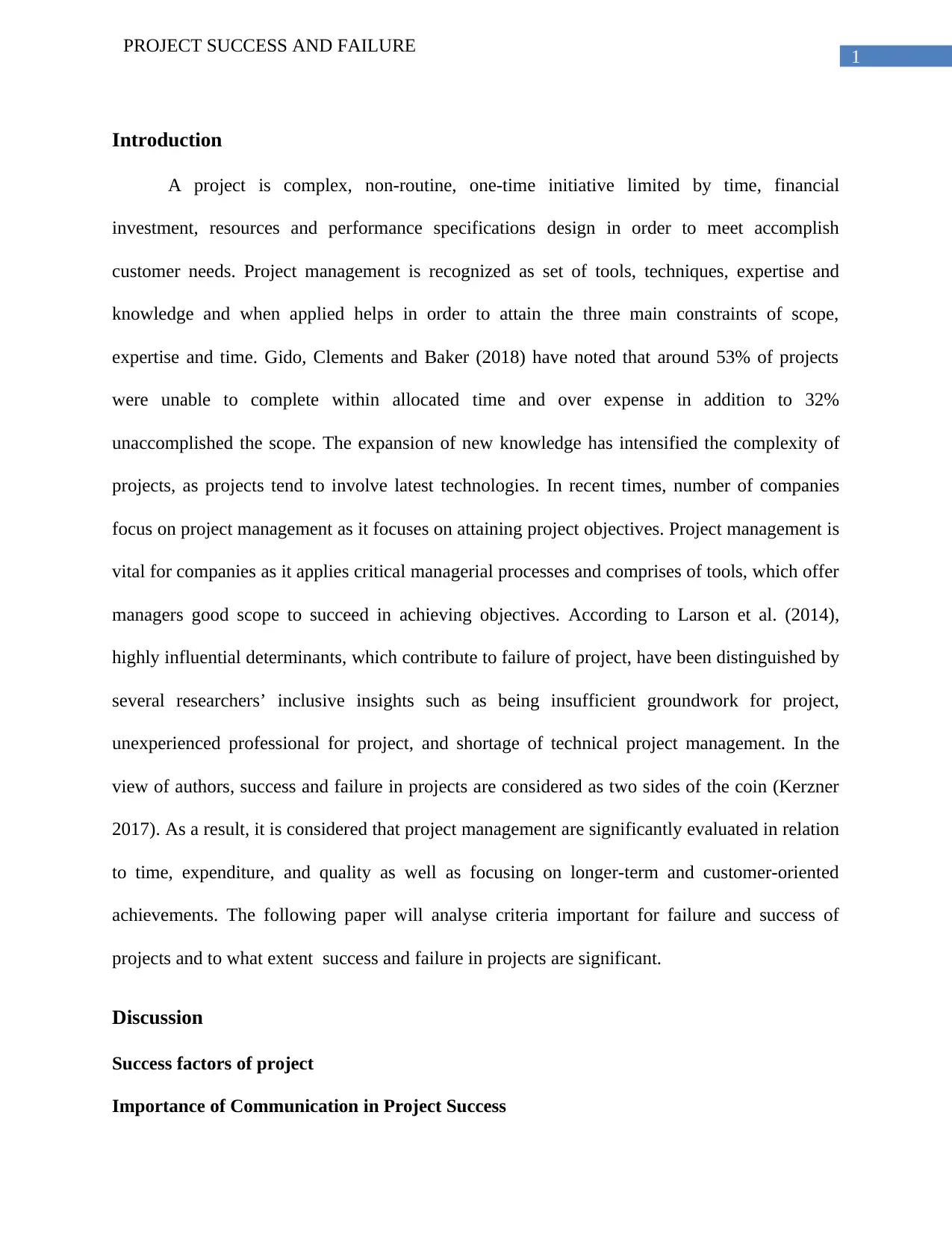
1
PROJECT SUCCESS AND FAILURE
Introduction
A project is complex, non-routine, one-time initiative limited by time, financial
investment, resources and performance specifications design in order to meet accomplish
customer needs. Project management is recognized as set of tools, techniques, expertise and
knowledge and when applied helps in order to attain the three main constraints of scope,
expertise and time. Gido, Clements and Baker (2018) have noted that around 53% of projects
were unable to complete within allocated time and over expense in addition to 32%
unaccomplished the scope. The expansion of new knowledge has intensified the complexity of
projects, as projects tend to involve latest technologies. In recent times, number of companies
focus on project management as it focuses on attaining project objectives. Project management is
vital for companies as it applies critical managerial processes and comprises of tools, which offer
managers good scope to succeed in achieving objectives. According to Larson et al. (2014),
highly influential determinants, which contribute to failure of project, have been distinguished by
several researchers’ inclusive insights such as being insufficient groundwork for project,
unexperienced professional for project, and shortage of technical project management. In the
view of authors, success and failure in projects are considered as two sides of the coin (Kerzner
2017). As a result, it is considered that project management are significantly evaluated in relation
to time, expenditure, and quality as well as focusing on longer-term and customer-oriented
achievements. The following paper will analyse criteria important for failure and success of
projects and to what extent success and failure in projects are significant.
Discussion
Success factors of project
Importance of Communication in Project Success
PROJECT SUCCESS AND FAILURE
Introduction
A project is complex, non-routine, one-time initiative limited by time, financial
investment, resources and performance specifications design in order to meet accomplish
customer needs. Project management is recognized as set of tools, techniques, expertise and
knowledge and when applied helps in order to attain the three main constraints of scope,
expertise and time. Gido, Clements and Baker (2018) have noted that around 53% of projects
were unable to complete within allocated time and over expense in addition to 32%
unaccomplished the scope. The expansion of new knowledge has intensified the complexity of
projects, as projects tend to involve latest technologies. In recent times, number of companies
focus on project management as it focuses on attaining project objectives. Project management is
vital for companies as it applies critical managerial processes and comprises of tools, which offer
managers good scope to succeed in achieving objectives. According to Larson et al. (2014),
highly influential determinants, which contribute to failure of project, have been distinguished by
several researchers’ inclusive insights such as being insufficient groundwork for project,
unexperienced professional for project, and shortage of technical project management. In the
view of authors, success and failure in projects are considered as two sides of the coin (Kerzner
2017). As a result, it is considered that project management are significantly evaluated in relation
to time, expenditure, and quality as well as focusing on longer-term and customer-oriented
achievements. The following paper will analyse criteria important for failure and success of
projects and to what extent success and failure in projects are significant.
Discussion
Success factors of project
Importance of Communication in Project Success
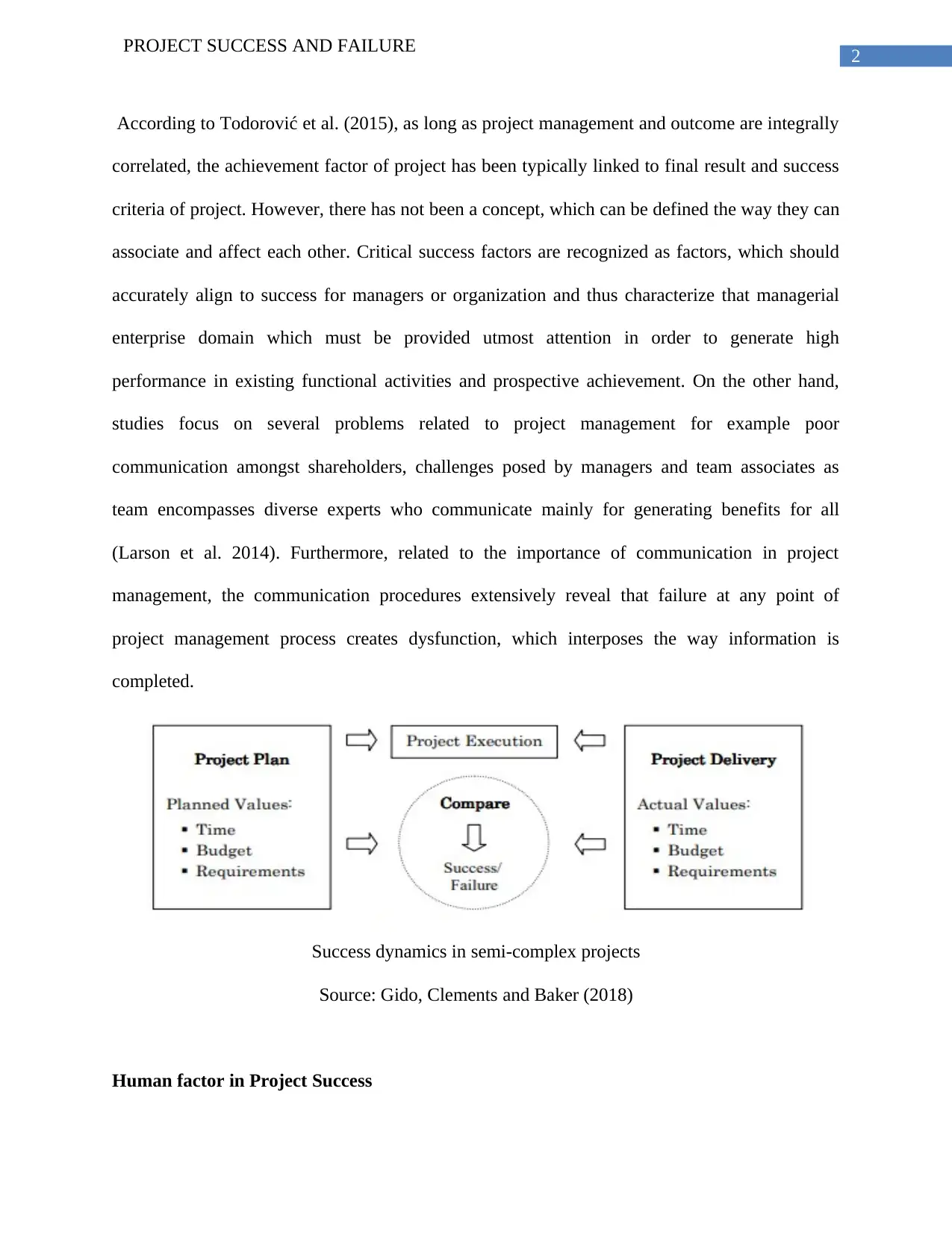
2
PROJECT SUCCESS AND FAILURE
According to Todorović et al. (2015), as long as project management and outcome are integrally
correlated, the achievement factor of project has been typically linked to final result and success
criteria of project. However, there has not been a concept, which can be defined the way they can
associate and affect each other. Critical success factors are recognized as factors, which should
accurately align to success for managers or organization and thus characterize that managerial
enterprise domain which must be provided utmost attention in order to generate high
performance in existing functional activities and prospective achievement. On the other hand,
studies focus on several problems related to project management for example poor
communication amongst shareholders, challenges posed by managers and team associates as
team encompasses diverse experts who communicate mainly for generating benefits for all
(Larson et al. 2014). Furthermore, related to the importance of communication in project
management, the communication procedures extensively reveal that failure at any point of
project management process creates dysfunction, which interposes the way information is
completed.
Success dynamics in semi-complex projects
Source: Gido, Clements and Baker (2018)
Human factor in Project Success
PROJECT SUCCESS AND FAILURE
According to Todorović et al. (2015), as long as project management and outcome are integrally
correlated, the achievement factor of project has been typically linked to final result and success
criteria of project. However, there has not been a concept, which can be defined the way they can
associate and affect each other. Critical success factors are recognized as factors, which should
accurately align to success for managers or organization and thus characterize that managerial
enterprise domain which must be provided utmost attention in order to generate high
performance in existing functional activities and prospective achievement. On the other hand,
studies focus on several problems related to project management for example poor
communication amongst shareholders, challenges posed by managers and team associates as
team encompasses diverse experts who communicate mainly for generating benefits for all
(Larson et al. 2014). Furthermore, related to the importance of communication in project
management, the communication procedures extensively reveal that failure at any point of
project management process creates dysfunction, which interposes the way information is
completed.
Success dynamics in semi-complex projects
Source: Gido, Clements and Baker (2018)
Human factor in Project Success
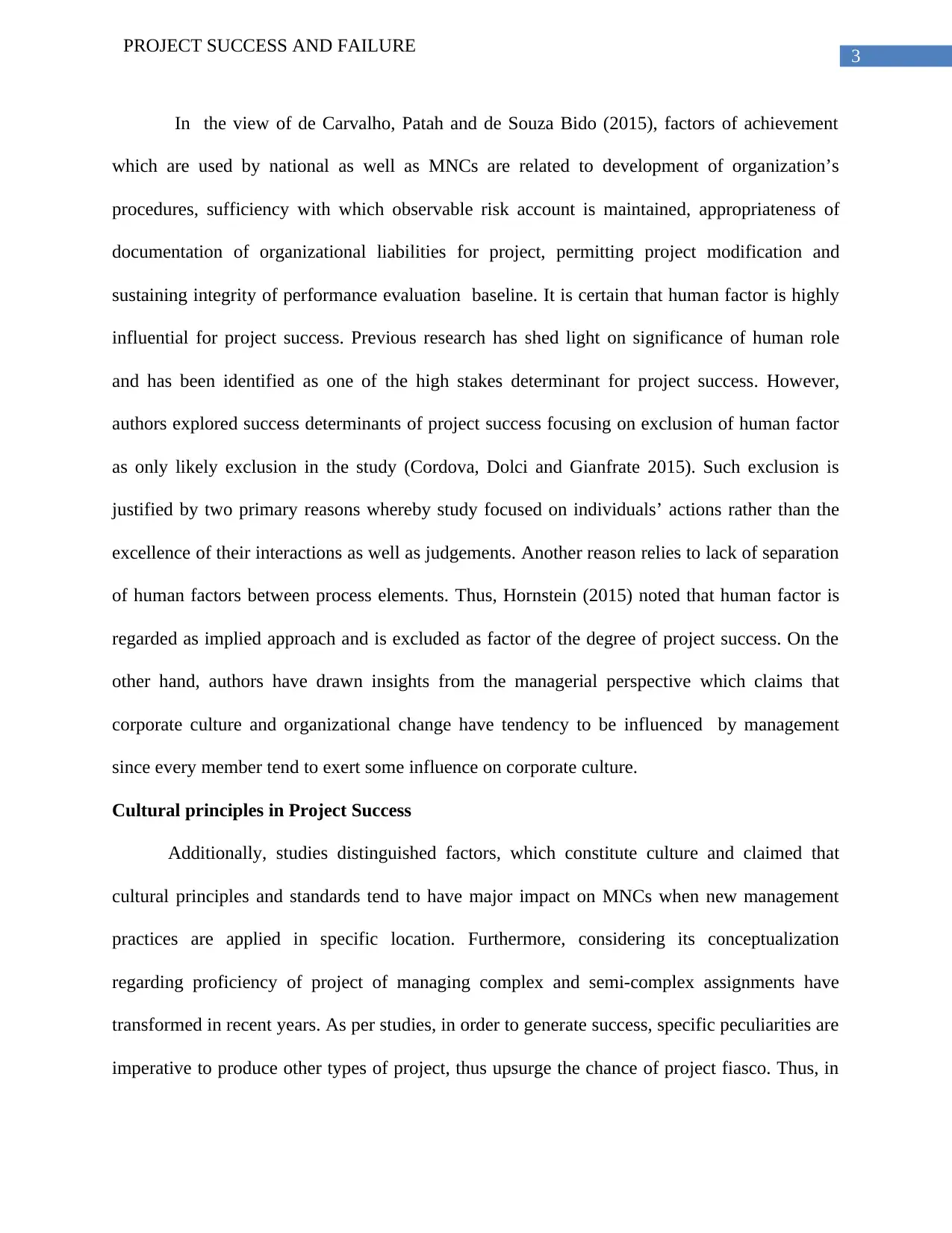
3
PROJECT SUCCESS AND FAILURE
In the view of de Carvalho, Patah and de Souza Bido (2015), factors of achievement
which are used by national as well as MNCs are related to development of organization’s
procedures, sufficiency with which observable risk account is maintained, appropriateness of
documentation of organizational liabilities for project, permitting project modification and
sustaining integrity of performance evaluation baseline. It is certain that human factor is highly
influential for project success. Previous research has shed light on significance of human role
and has been identified as one of the high stakes determinant for project success. However,
authors explored success determinants of project success focusing on exclusion of human factor
as only likely exclusion in the study (Cordova, Dolci and Gianfrate 2015). Such exclusion is
justified by two primary reasons whereby study focused on individuals’ actions rather than the
excellence of their interactions as well as judgements. Another reason relies to lack of separation
of human factors between process elements. Thus, Hornstein (2015) noted that human factor is
regarded as implied approach and is excluded as factor of the degree of project success. On the
other hand, authors have drawn insights from the managerial perspective which claims that
corporate culture and organizational change have tendency to be influenced by management
since every member tend to exert some influence on corporate culture.
Cultural principles in Project Success
Additionally, studies distinguished factors, which constitute culture and claimed that
cultural principles and standards tend to have major impact on MNCs when new management
practices are applied in specific location. Furthermore, considering its conceptualization
regarding proficiency of project of managing complex and semi-complex assignments have
transformed in recent years. As per studies, in order to generate success, specific peculiarities are
imperative to produce other types of project, thus upsurge the chance of project fiasco. Thus, in
PROJECT SUCCESS AND FAILURE
In the view of de Carvalho, Patah and de Souza Bido (2015), factors of achievement
which are used by national as well as MNCs are related to development of organization’s
procedures, sufficiency with which observable risk account is maintained, appropriateness of
documentation of organizational liabilities for project, permitting project modification and
sustaining integrity of performance evaluation baseline. It is certain that human factor is highly
influential for project success. Previous research has shed light on significance of human role
and has been identified as one of the high stakes determinant for project success. However,
authors explored success determinants of project success focusing on exclusion of human factor
as only likely exclusion in the study (Cordova, Dolci and Gianfrate 2015). Such exclusion is
justified by two primary reasons whereby study focused on individuals’ actions rather than the
excellence of their interactions as well as judgements. Another reason relies to lack of separation
of human factors between process elements. Thus, Hornstein (2015) noted that human factor is
regarded as implied approach and is excluded as factor of the degree of project success. On the
other hand, authors have drawn insights from the managerial perspective which claims that
corporate culture and organizational change have tendency to be influenced by management
since every member tend to exert some influence on corporate culture.
Cultural principles in Project Success
Additionally, studies distinguished factors, which constitute culture and claimed that
cultural principles and standards tend to have major impact on MNCs when new management
practices are applied in specific location. Furthermore, considering its conceptualization
regarding proficiency of project of managing complex and semi-complex assignments have
transformed in recent years. As per studies, in order to generate success, specific peculiarities are
imperative to produce other types of project, thus upsurge the chance of project fiasco. Thus, in
Secure Best Marks with AI Grader
Need help grading? Try our AI Grader for instant feedback on your assignments.
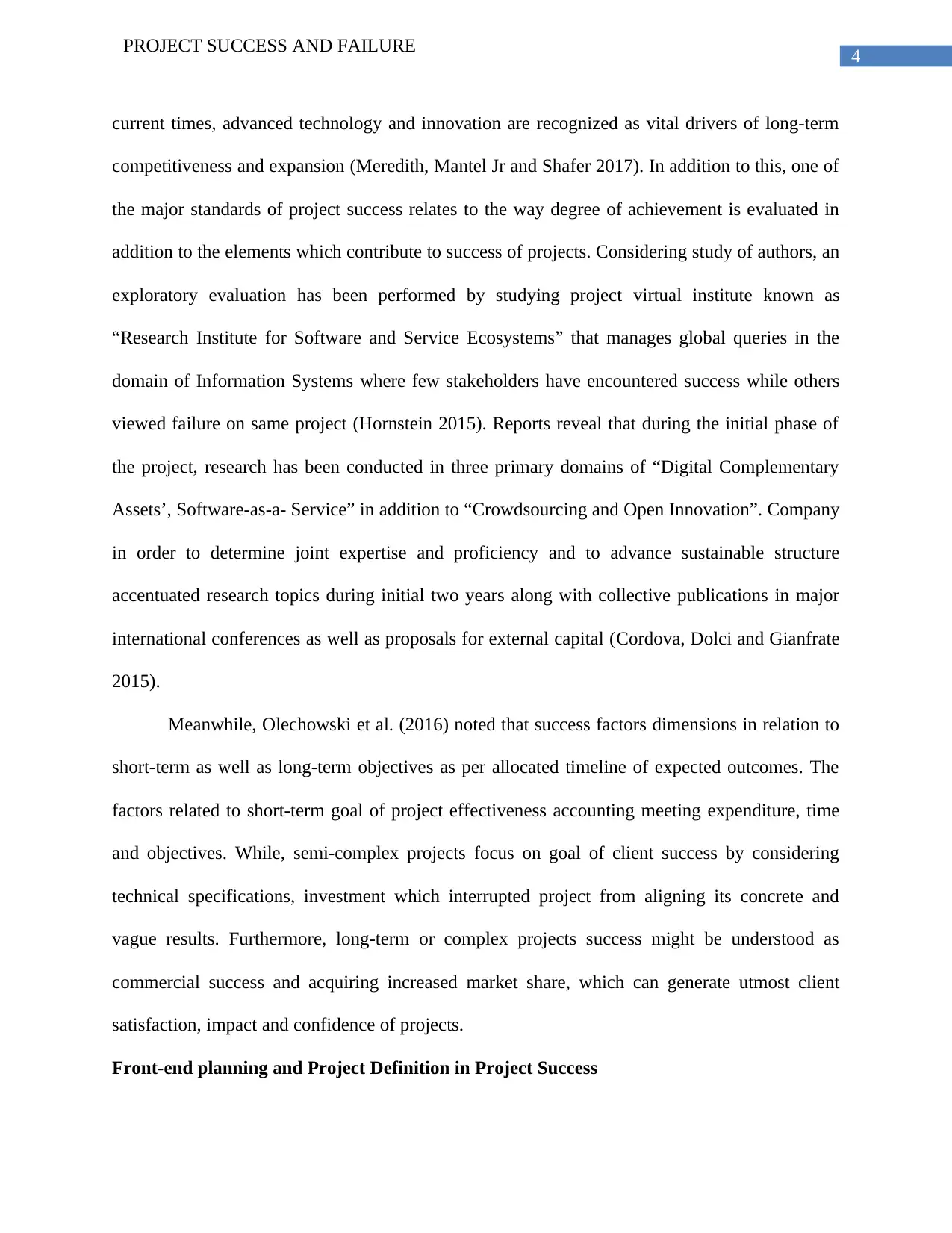
4
PROJECT SUCCESS AND FAILURE
current times, advanced technology and innovation are recognized as vital drivers of long-term
competitiveness and expansion (Meredith, Mantel Jr and Shafer 2017). In addition to this, one of
the major standards of project success relates to the way degree of achievement is evaluated in
addition to the elements which contribute to success of projects. Considering study of authors, an
exploratory evaluation has been performed by studying project virtual institute known as
“Research Institute for Software and Service Ecosystems” that manages global queries in the
domain of Information Systems where few stakeholders have encountered success while others
viewed failure on same project (Hornstein 2015). Reports reveal that during the initial phase of
the project, research has been conducted in three primary domains of “Digital Complementary
Assets’, Software-as-a- Service” in addition to “Crowdsourcing and Open Innovation”. Company
in order to determine joint expertise and proficiency and to advance sustainable structure
accentuated research topics during initial two years along with collective publications in major
international conferences as well as proposals for external capital (Cordova, Dolci and Gianfrate
2015).
Meanwhile, Olechowski et al. (2016) noted that success factors dimensions in relation to
short-term as well as long-term objectives as per allocated timeline of expected outcomes. The
factors related to short-term goal of project effectiveness accounting meeting expenditure, time
and objectives. While, semi-complex projects focus on goal of client success by considering
technical specifications, investment which interrupted project from aligning its concrete and
vague results. Furthermore, long-term or complex projects success might be understood as
commercial success and acquiring increased market share, which can generate utmost client
satisfaction, impact and confidence of projects.
Front-end planning and Project Definition in Project Success
PROJECT SUCCESS AND FAILURE
current times, advanced technology and innovation are recognized as vital drivers of long-term
competitiveness and expansion (Meredith, Mantel Jr and Shafer 2017). In addition to this, one of
the major standards of project success relates to the way degree of achievement is evaluated in
addition to the elements which contribute to success of projects. Considering study of authors, an
exploratory evaluation has been performed by studying project virtual institute known as
“Research Institute for Software and Service Ecosystems” that manages global queries in the
domain of Information Systems where few stakeholders have encountered success while others
viewed failure on same project (Hornstein 2015). Reports reveal that during the initial phase of
the project, research has been conducted in three primary domains of “Digital Complementary
Assets’, Software-as-a- Service” in addition to “Crowdsourcing and Open Innovation”. Company
in order to determine joint expertise and proficiency and to advance sustainable structure
accentuated research topics during initial two years along with collective publications in major
international conferences as well as proposals for external capital (Cordova, Dolci and Gianfrate
2015).
Meanwhile, Olechowski et al. (2016) noted that success factors dimensions in relation to
short-term as well as long-term objectives as per allocated timeline of expected outcomes. The
factors related to short-term goal of project effectiveness accounting meeting expenditure, time
and objectives. While, semi-complex projects focus on goal of client success by considering
technical specifications, investment which interrupted project from aligning its concrete and
vague results. Furthermore, long-term or complex projects success might be understood as
commercial success and acquiring increased market share, which can generate utmost client
satisfaction, impact and confidence of projects.
Front-end planning and Project Definition in Project Success
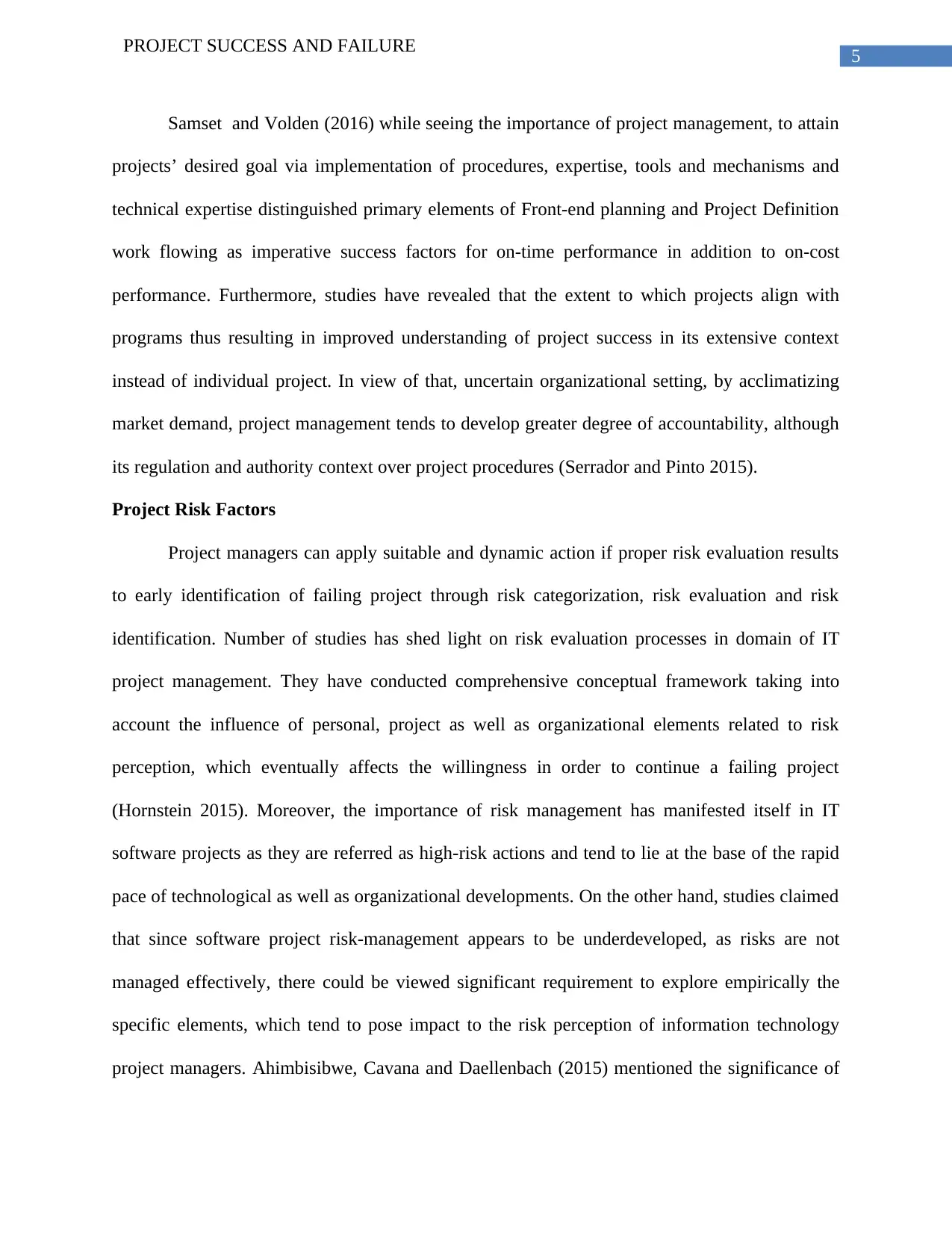
5
PROJECT SUCCESS AND FAILURE
Samset and Volden (2016) while seeing the importance of project management, to attain
projects’ desired goal via implementation of procedures, expertise, tools and mechanisms and
technical expertise distinguished primary elements of Front-end planning and Project Definition
work flowing as imperative success factors for on-time performance in addition to on-cost
performance. Furthermore, studies have revealed that the extent to which projects align with
programs thus resulting in improved understanding of project success in its extensive context
instead of individual project. In view of that, uncertain organizational setting, by acclimatizing
market demand, project management tends to develop greater degree of accountability, although
its regulation and authority context over project procedures (Serrador and Pinto 2015).
Project Risk Factors
Project managers can apply suitable and dynamic action if proper risk evaluation results
to early identification of failing project through risk categorization, risk evaluation and risk
identification. Number of studies has shed light on risk evaluation processes in domain of IT
project management. They have conducted comprehensive conceptual framework taking into
account the influence of personal, project as well as organizational elements related to risk
perception, which eventually affects the willingness in order to continue a failing project
(Hornstein 2015). Moreover, the importance of risk management has manifested itself in IT
software projects as they are referred as high-risk actions and tend to lie at the base of the rapid
pace of technological as well as organizational developments. On the other hand, studies claimed
that since software project risk-management appears to be underdeveloped, as risks are not
managed effectively, there could be viewed significant requirement to explore empirically the
specific elements, which tend to pose impact to the risk perception of information technology
project managers. Ahimbisibwe, Cavana and Daellenbach (2015) mentioned the significance of
PROJECT SUCCESS AND FAILURE
Samset and Volden (2016) while seeing the importance of project management, to attain
projects’ desired goal via implementation of procedures, expertise, tools and mechanisms and
technical expertise distinguished primary elements of Front-end planning and Project Definition
work flowing as imperative success factors for on-time performance in addition to on-cost
performance. Furthermore, studies have revealed that the extent to which projects align with
programs thus resulting in improved understanding of project success in its extensive context
instead of individual project. In view of that, uncertain organizational setting, by acclimatizing
market demand, project management tends to develop greater degree of accountability, although
its regulation and authority context over project procedures (Serrador and Pinto 2015).
Project Risk Factors
Project managers can apply suitable and dynamic action if proper risk evaluation results
to early identification of failing project through risk categorization, risk evaluation and risk
identification. Number of studies has shed light on risk evaluation processes in domain of IT
project management. They have conducted comprehensive conceptual framework taking into
account the influence of personal, project as well as organizational elements related to risk
perception, which eventually affects the willingness in order to continue a failing project
(Hornstein 2015). Moreover, the importance of risk management has manifested itself in IT
software projects as they are referred as high-risk actions and tend to lie at the base of the rapid
pace of technological as well as organizational developments. On the other hand, studies claimed
that since software project risk-management appears to be underdeveloped, as risks are not
managed effectively, there could be viewed significant requirement to explore empirically the
specific elements, which tend to pose impact to the risk perception of information technology
project managers. Ahimbisibwe, Cavana and Daellenbach (2015) mentioned the significance of
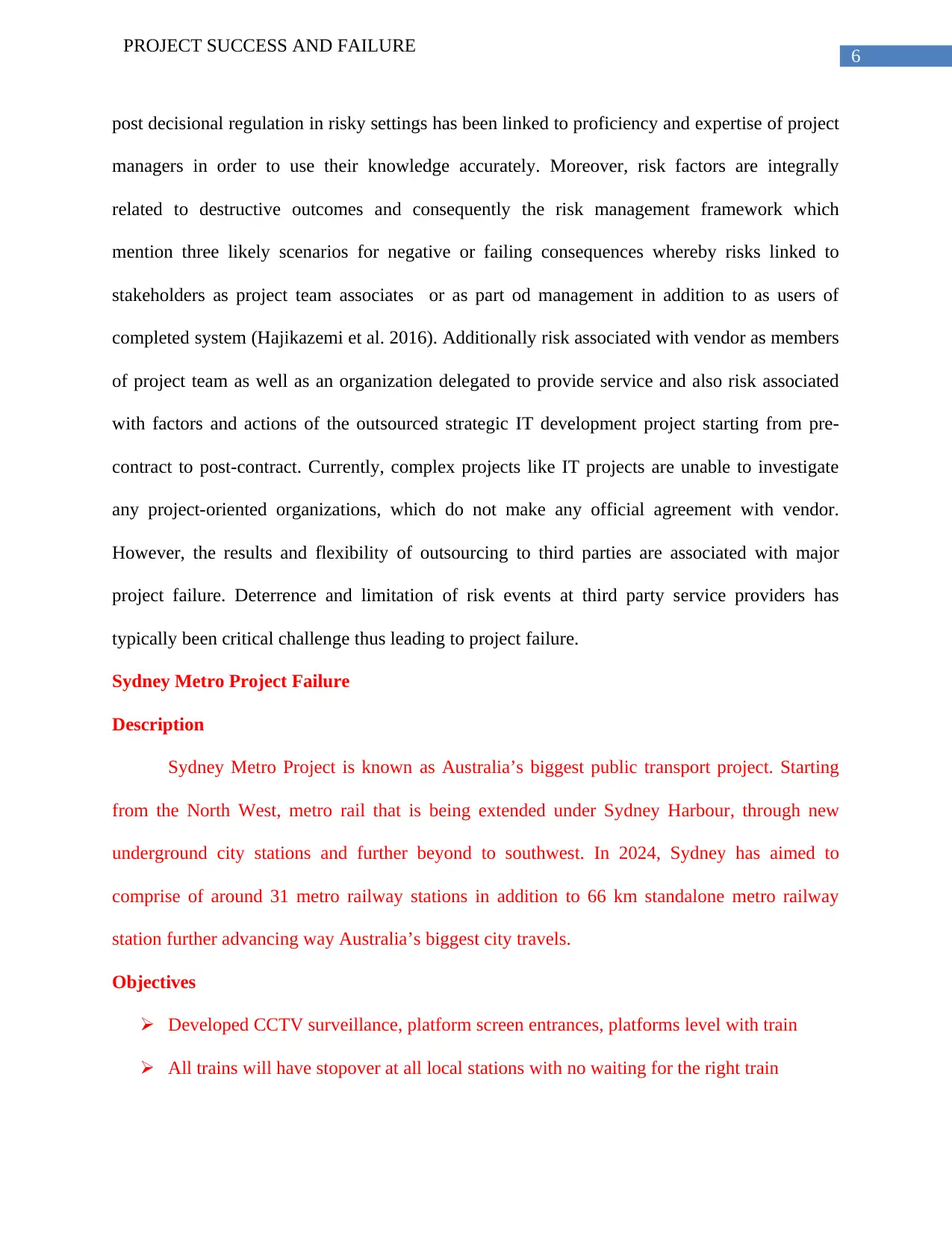
6
PROJECT SUCCESS AND FAILURE
post decisional regulation in risky settings has been linked to proficiency and expertise of project
managers in order to use their knowledge accurately. Moreover, risk factors are integrally
related to destructive outcomes and consequently the risk management framework which
mention three likely scenarios for negative or failing consequences whereby risks linked to
stakeholders as project team associates or as part od management in addition to as users of
completed system (Hajikazemi et al. 2016). Additionally risk associated with vendor as members
of project team as well as an organization delegated to provide service and also risk associated
with factors and actions of the outsourced strategic IT development project starting from pre-
contract to post-contract. Currently, complex projects like IT projects are unable to investigate
any project-oriented organizations, which do not make any official agreement with vendor.
However, the results and flexibility of outsourcing to third parties are associated with major
project failure. Deterrence and limitation of risk events at third party service providers has
typically been critical challenge thus leading to project failure.
Sydney Metro Project Failure
Description
Sydney Metro Project is known as Australia’s biggest public transport project. Starting
from the North West, metro rail that is being extended under Sydney Harbour, through new
underground city stations and further beyond to southwest. In 2024, Sydney has aimed to
comprise of around 31 metro railway stations in addition to 66 km standalone metro railway
station further advancing way Australia’s biggest city travels.
Objectives
Developed CCTV surveillance, platform screen entrances, platforms level with train
All trains will have stopover at all local stations with no waiting for the right train
PROJECT SUCCESS AND FAILURE
post decisional regulation in risky settings has been linked to proficiency and expertise of project
managers in order to use their knowledge accurately. Moreover, risk factors are integrally
related to destructive outcomes and consequently the risk management framework which
mention three likely scenarios for negative or failing consequences whereby risks linked to
stakeholders as project team associates or as part od management in addition to as users of
completed system (Hajikazemi et al. 2016). Additionally risk associated with vendor as members
of project team as well as an organization delegated to provide service and also risk associated
with factors and actions of the outsourced strategic IT development project starting from pre-
contract to post-contract. Currently, complex projects like IT projects are unable to investigate
any project-oriented organizations, which do not make any official agreement with vendor.
However, the results and flexibility of outsourcing to third parties are associated with major
project failure. Deterrence and limitation of risk events at third party service providers has
typically been critical challenge thus leading to project failure.
Sydney Metro Project Failure
Description
Sydney Metro Project is known as Australia’s biggest public transport project. Starting
from the North West, metro rail that is being extended under Sydney Harbour, through new
underground city stations and further beyond to southwest. In 2024, Sydney has aimed to
comprise of around 31 metro railway stations in addition to 66 km standalone metro railway
station further advancing way Australia’s biggest city travels.
Objectives
Developed CCTV surveillance, platform screen entrances, platforms level with train
All trains will have stopover at all local stations with no waiting for the right train
Paraphrase This Document
Need a fresh take? Get an instant paraphrase of this document with our AI Paraphraser
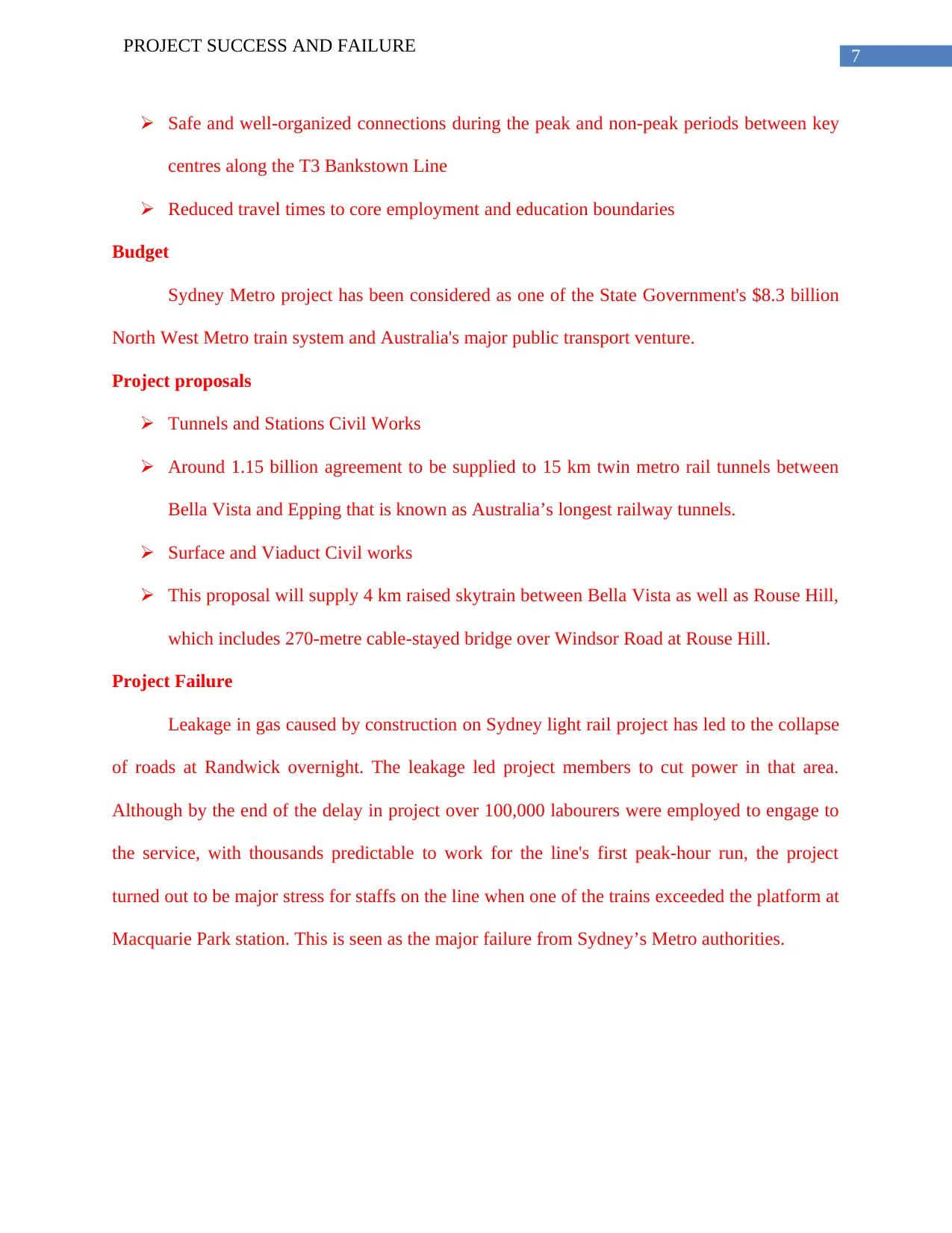
7
PROJECT SUCCESS AND FAILURE
Safe and well-organized connections during the peak and non-peak periods between key
centres along the T3 Bankstown Line
Reduced travel times to core employment and education boundaries
Budget
Sydney Metro project has been considered as one of the State Government's $8.3 billion
North West Metro train system and Australia's major public transport venture.
Project proposals
Tunnels and Stations Civil Works
Around 1.15 billion agreement to be supplied to 15 km twin metro rail tunnels between
Bella Vista and Epping that is known as Australia’s longest railway tunnels.
Surface and Viaduct Civil works
This proposal will supply 4 km raised skytrain between Bella Vista as well as Rouse Hill,
which includes 270-metre cable-stayed bridge over Windsor Road at Rouse Hill.
Project Failure
Leakage in gas caused by construction on Sydney light rail project has led to the collapse
of roads at Randwick overnight. The leakage led project members to cut power in that area.
Although by the end of the delay in project over 100,000 labourers were employed to engage to
the service, with thousands predictable to work for the line's first peak-hour run, the project
turned out to be major stress for staffs on the line when one of the trains exceeded the platform at
Macquarie Park station. This is seen as the major failure from Sydney’s Metro authorities.
PROJECT SUCCESS AND FAILURE
Safe and well-organized connections during the peak and non-peak periods between key
centres along the T3 Bankstown Line
Reduced travel times to core employment and education boundaries
Budget
Sydney Metro project has been considered as one of the State Government's $8.3 billion
North West Metro train system and Australia's major public transport venture.
Project proposals
Tunnels and Stations Civil Works
Around 1.15 billion agreement to be supplied to 15 km twin metro rail tunnels between
Bella Vista and Epping that is known as Australia’s longest railway tunnels.
Surface and Viaduct Civil works
This proposal will supply 4 km raised skytrain between Bella Vista as well as Rouse Hill,
which includes 270-metre cable-stayed bridge over Windsor Road at Rouse Hill.
Project Failure
Leakage in gas caused by construction on Sydney light rail project has led to the collapse
of roads at Randwick overnight. The leakage led project members to cut power in that area.
Although by the end of the delay in project over 100,000 labourers were employed to engage to
the service, with thousands predictable to work for the line's first peak-hour run, the project
turned out to be major stress for staffs on the line when one of the trains exceeded the platform at
Macquarie Park station. This is seen as the major failure from Sydney’s Metro authorities.
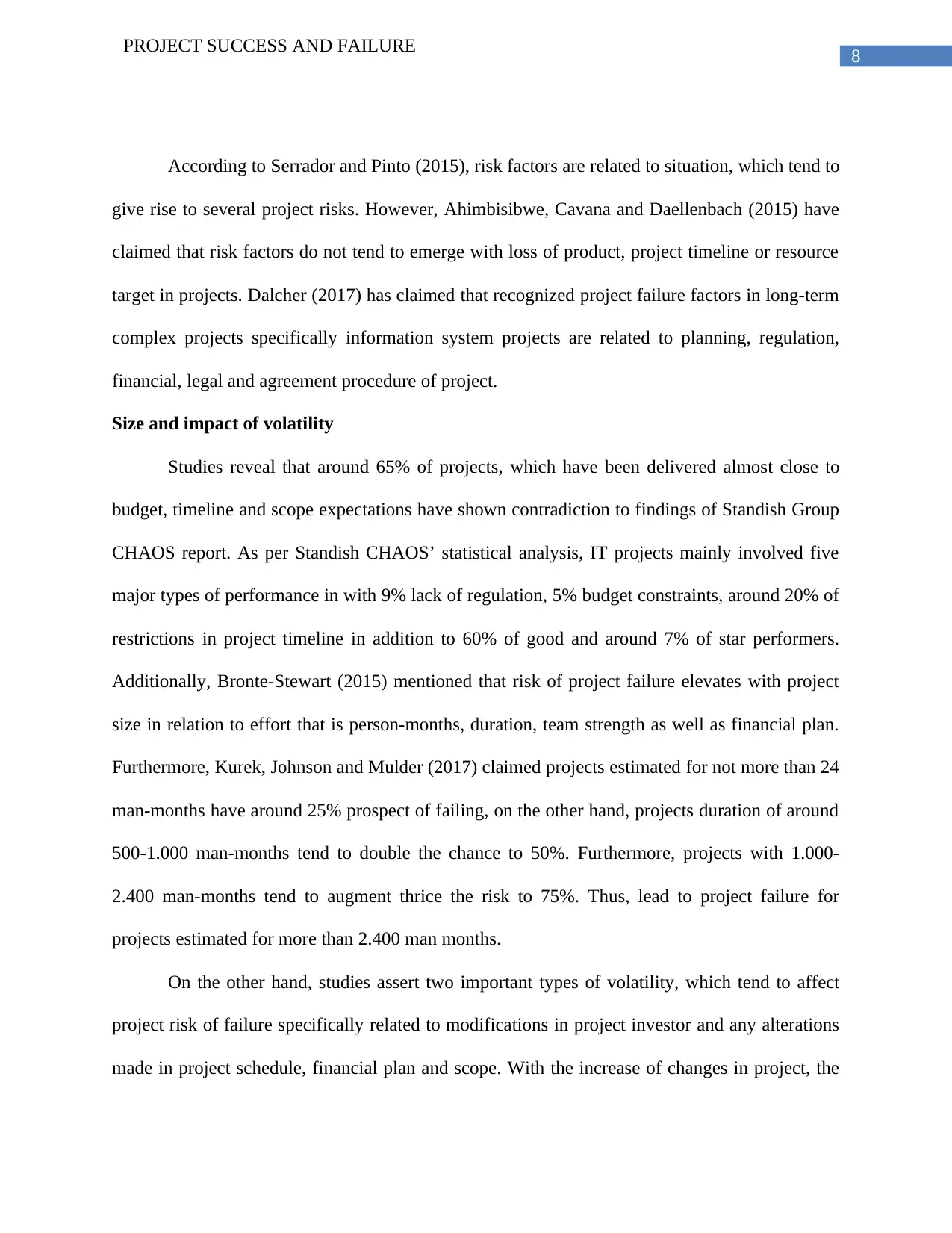
8
PROJECT SUCCESS AND FAILURE
According to Serrador and Pinto (2015), risk factors are related to situation, which tend to
give rise to several project risks. However, Ahimbisibwe, Cavana and Daellenbach (2015) have
claimed that risk factors do not tend to emerge with loss of product, project timeline or resource
target in projects. Dalcher (2017) has claimed that recognized project failure factors in long-term
complex projects specifically information system projects are related to planning, regulation,
financial, legal and agreement procedure of project.
Size and impact of volatility
Studies reveal that around 65% of projects, which have been delivered almost close to
budget, timeline and scope expectations have shown contradiction to findings of Standish Group
CHAOS report. As per Standish CHAOS’ statistical analysis, IT projects mainly involved five
major types of performance in with 9% lack of regulation, 5% budget constraints, around 20% of
restrictions in project timeline in addition to 60% of good and around 7% of star performers.
Additionally, Bronte-Stewart (2015) mentioned that risk of project failure elevates with project
size in relation to effort that is person-months, duration, team strength as well as financial plan.
Furthermore, Kurek, Johnson and Mulder (2017) claimed projects estimated for not more than 24
man-months have around 25% prospect of failing, on the other hand, projects duration of around
500-1.000 man-months tend to double the chance to 50%. Furthermore, projects with 1.000-
2.400 man-months tend to augment thrice the risk to 75%. Thus, lead to project failure for
projects estimated for more than 2.400 man months.
On the other hand, studies assert two important types of volatility, which tend to affect
project risk of failure specifically related to modifications in project investor and any alterations
made in project schedule, financial plan and scope. With the increase of changes in project, the
PROJECT SUCCESS AND FAILURE
According to Serrador and Pinto (2015), risk factors are related to situation, which tend to
give rise to several project risks. However, Ahimbisibwe, Cavana and Daellenbach (2015) have
claimed that risk factors do not tend to emerge with loss of product, project timeline or resource
target in projects. Dalcher (2017) has claimed that recognized project failure factors in long-term
complex projects specifically information system projects are related to planning, regulation,
financial, legal and agreement procedure of project.
Size and impact of volatility
Studies reveal that around 65% of projects, which have been delivered almost close to
budget, timeline and scope expectations have shown contradiction to findings of Standish Group
CHAOS report. As per Standish CHAOS’ statistical analysis, IT projects mainly involved five
major types of performance in with 9% lack of regulation, 5% budget constraints, around 20% of
restrictions in project timeline in addition to 60% of good and around 7% of star performers.
Additionally, Bronte-Stewart (2015) mentioned that risk of project failure elevates with project
size in relation to effort that is person-months, duration, team strength as well as financial plan.
Furthermore, Kurek, Johnson and Mulder (2017) claimed projects estimated for not more than 24
man-months have around 25% prospect of failing, on the other hand, projects duration of around
500-1.000 man-months tend to double the chance to 50%. Furthermore, projects with 1.000-
2.400 man-months tend to augment thrice the risk to 75%. Thus, lead to project failure for
projects estimated for more than 2.400 man months.
On the other hand, studies assert two important types of volatility, which tend to affect
project risk of failure specifically related to modifications in project investor and any alterations
made in project schedule, financial plan and scope. With the increase of changes in project, the
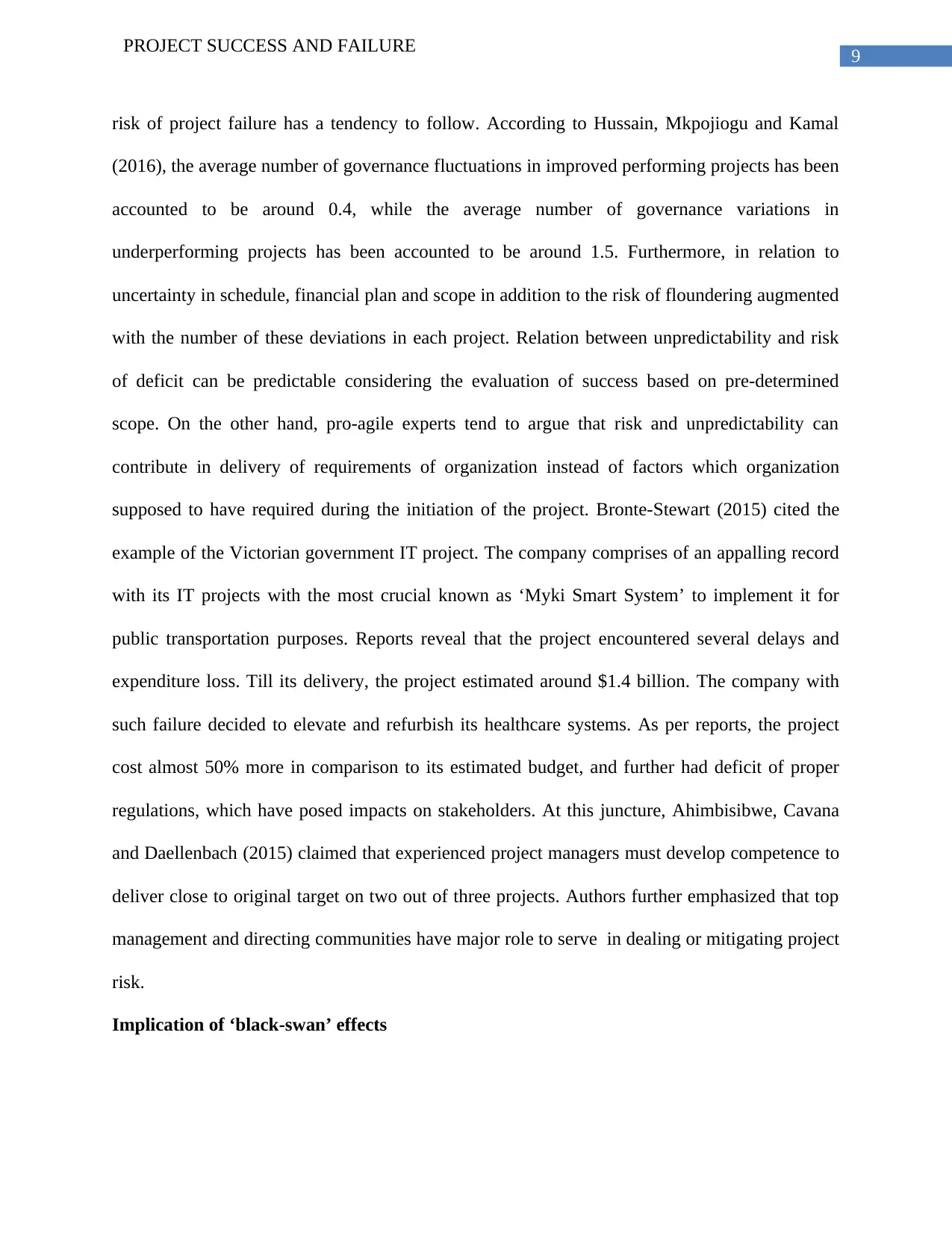
9
PROJECT SUCCESS AND FAILURE
risk of project failure has a tendency to follow. According to Hussain, Mkpojiogu and Kamal
(2016), the average number of governance fluctuations in improved performing projects has been
accounted to be around 0.4, while the average number of governance variations in
underperforming projects has been accounted to be around 1.5. Furthermore, in relation to
uncertainty in schedule, financial plan and scope in addition to the risk of floundering augmented
with the number of these deviations in each project. Relation between unpredictability and risk
of deficit can be predictable considering the evaluation of success based on pre-determined
scope. On the other hand, pro-agile experts tend to argue that risk and unpredictability can
contribute in delivery of requirements of organization instead of factors which organization
supposed to have required during the initiation of the project. Bronte-Stewart (2015) cited the
example of the Victorian government IT project. The company comprises of an appalling record
with its IT projects with the most crucial known as ‘Myki Smart System’ to implement it for
public transportation purposes. Reports reveal that the project encountered several delays and
expenditure loss. Till its delivery, the project estimated around $1.4 billion. The company with
such failure decided to elevate and refurbish its healthcare systems. As per reports, the project
cost almost 50% more in comparison to its estimated budget, and further had deficit of proper
regulations, which have posed impacts on stakeholders. At this juncture, Ahimbisibwe, Cavana
and Daellenbach (2015) claimed that experienced project managers must develop competence to
deliver close to original target on two out of three projects. Authors further emphasized that top
management and directing communities have major role to serve in dealing or mitigating project
risk.
Implication of ‘black-swan’ effects
PROJECT SUCCESS AND FAILURE
risk of project failure has a tendency to follow. According to Hussain, Mkpojiogu and Kamal
(2016), the average number of governance fluctuations in improved performing projects has been
accounted to be around 0.4, while the average number of governance variations in
underperforming projects has been accounted to be around 1.5. Furthermore, in relation to
uncertainty in schedule, financial plan and scope in addition to the risk of floundering augmented
with the number of these deviations in each project. Relation between unpredictability and risk
of deficit can be predictable considering the evaluation of success based on pre-determined
scope. On the other hand, pro-agile experts tend to argue that risk and unpredictability can
contribute in delivery of requirements of organization instead of factors which organization
supposed to have required during the initiation of the project. Bronte-Stewart (2015) cited the
example of the Victorian government IT project. The company comprises of an appalling record
with its IT projects with the most crucial known as ‘Myki Smart System’ to implement it for
public transportation purposes. Reports reveal that the project encountered several delays and
expenditure loss. Till its delivery, the project estimated around $1.4 billion. The company with
such failure decided to elevate and refurbish its healthcare systems. As per reports, the project
cost almost 50% more in comparison to its estimated budget, and further had deficit of proper
regulations, which have posed impacts on stakeholders. At this juncture, Ahimbisibwe, Cavana
and Daellenbach (2015) claimed that experienced project managers must develop competence to
deliver close to original target on two out of three projects. Authors further emphasized that top
management and directing communities have major role to serve in dealing or mitigating project
risk.
Implication of ‘black-swan’ effects
Secure Best Marks with AI Grader
Need help grading? Try our AI Grader for instant feedback on your assignments.
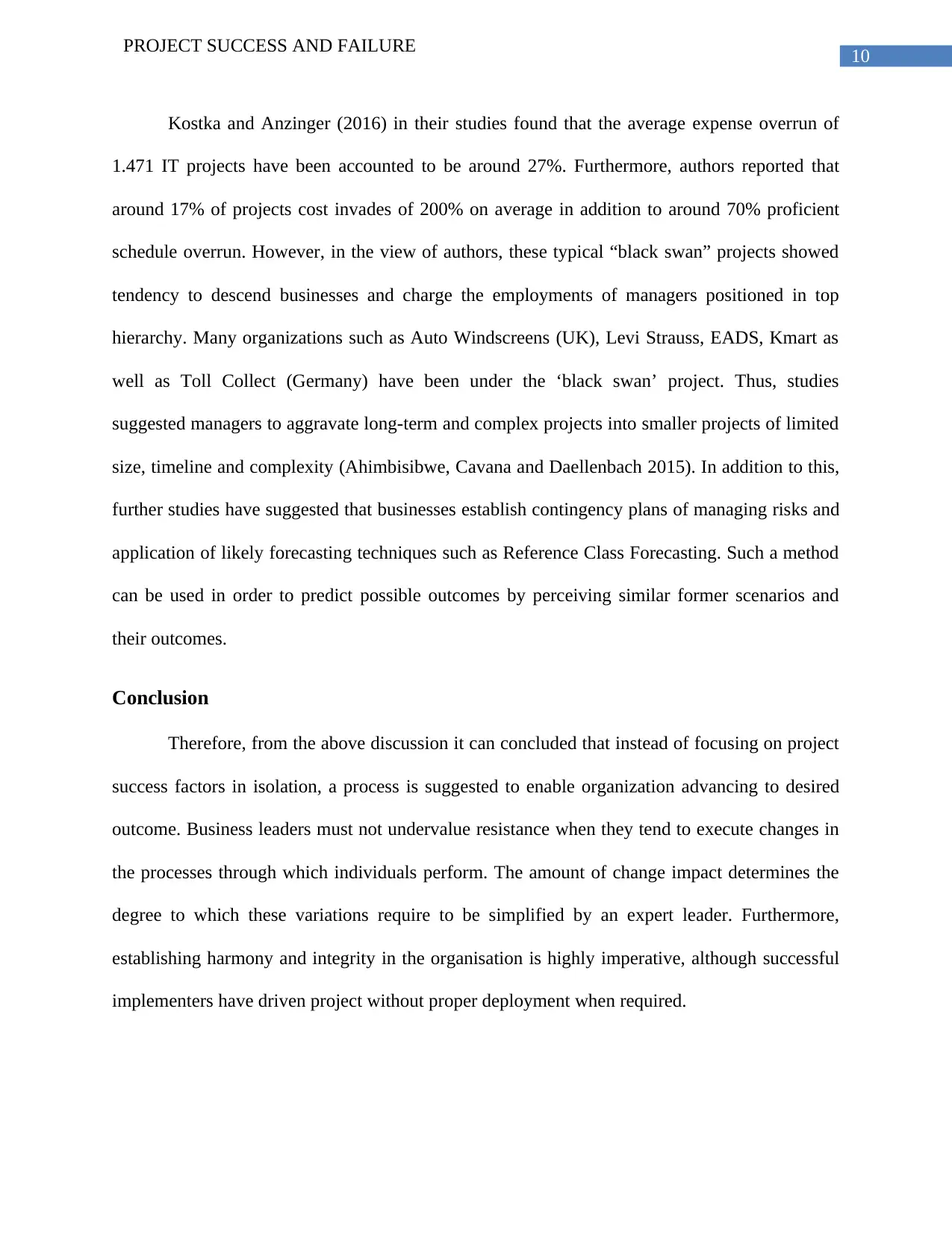
10
PROJECT SUCCESS AND FAILURE
Kostka and Anzinger (2016) in their studies found that the average expense overrun of
1.471 IT projects have been accounted to be around 27%. Furthermore, authors reported that
around 17% of projects cost invades of 200% on average in addition to around 70% proficient
schedule overrun. However, in the view of authors, these typical “black swan” projects showed
tendency to descend businesses and charge the employments of managers positioned in top
hierarchy. Many organizations such as Auto Windscreens (UK), Levi Strauss, EADS, Kmart as
well as Toll Collect (Germany) have been under the ‘black swan’ project. Thus, studies
suggested managers to aggravate long-term and complex projects into smaller projects of limited
size, timeline and complexity (Ahimbisibwe, Cavana and Daellenbach 2015). In addition to this,
further studies have suggested that businesses establish contingency plans of managing risks and
application of likely forecasting techniques such as Reference Class Forecasting. Such a method
can be used in order to predict possible outcomes by perceiving similar former scenarios and
their outcomes.
Conclusion
Therefore, from the above discussion it can concluded that instead of focusing on project
success factors in isolation, a process is suggested to enable organization advancing to desired
outcome. Business leaders must not undervalue resistance when they tend to execute changes in
the processes through which individuals perform. The amount of change impact determines the
degree to which these variations require to be simplified by an expert leader. Furthermore,
establishing harmony and integrity in the organisation is highly imperative, although successful
implementers have driven project without proper deployment when required.
PROJECT SUCCESS AND FAILURE
Kostka and Anzinger (2016) in their studies found that the average expense overrun of
1.471 IT projects have been accounted to be around 27%. Furthermore, authors reported that
around 17% of projects cost invades of 200% on average in addition to around 70% proficient
schedule overrun. However, in the view of authors, these typical “black swan” projects showed
tendency to descend businesses and charge the employments of managers positioned in top
hierarchy. Many organizations such as Auto Windscreens (UK), Levi Strauss, EADS, Kmart as
well as Toll Collect (Germany) have been under the ‘black swan’ project. Thus, studies
suggested managers to aggravate long-term and complex projects into smaller projects of limited
size, timeline and complexity (Ahimbisibwe, Cavana and Daellenbach 2015). In addition to this,
further studies have suggested that businesses establish contingency plans of managing risks and
application of likely forecasting techniques such as Reference Class Forecasting. Such a method
can be used in order to predict possible outcomes by perceiving similar former scenarios and
their outcomes.
Conclusion
Therefore, from the above discussion it can concluded that instead of focusing on project
success factors in isolation, a process is suggested to enable organization advancing to desired
outcome. Business leaders must not undervalue resistance when they tend to execute changes in
the processes through which individuals perform. The amount of change impact determines the
degree to which these variations require to be simplified by an expert leader. Furthermore,
establishing harmony and integrity in the organisation is highly imperative, although successful
implementers have driven project without proper deployment when required.
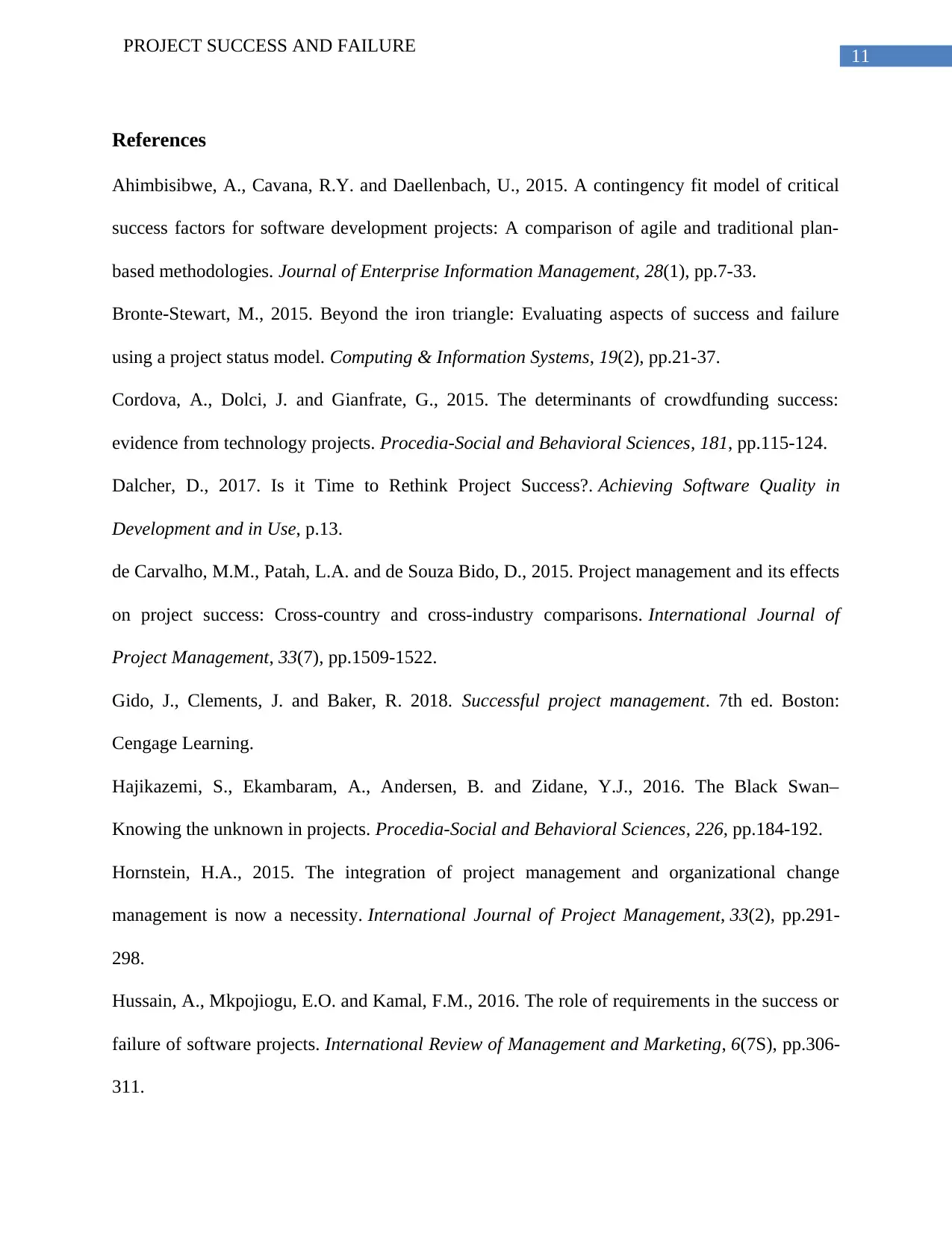
11
PROJECT SUCCESS AND FAILURE
References
Ahimbisibwe, A., Cavana, R.Y. and Daellenbach, U., 2015. A contingency fit model of critical
success factors for software development projects: A comparison of agile and traditional plan-
based methodologies. Journal of Enterprise Information Management, 28(1), pp.7-33.
Bronte-Stewart, M., 2015. Beyond the iron triangle: Evaluating aspects of success and failure
using a project status model. Computing & Information Systems, 19(2), pp.21-37.
Cordova, A., Dolci, J. and Gianfrate, G., 2015. The determinants of crowdfunding success:
evidence from technology projects. Procedia-Social and Behavioral Sciences, 181, pp.115-124.
Dalcher, D., 2017. Is it Time to Rethink Project Success?. Achieving Software Quality in
Development and in Use, p.13.
de Carvalho, M.M., Patah, L.A. and de Souza Bido, D., 2015. Project management and its effects
on project success: Cross-country and cross-industry comparisons. International Journal of
Project Management, 33(7), pp.1509-1522.
Gido, J., Clements, J. and Baker, R. 2018. Successful project management. 7th ed. Boston:
Cengage Learning.
Hajikazemi, S., Ekambaram, A., Andersen, B. and Zidane, Y.J., 2016. The Black Swan–
Knowing the unknown in projects. Procedia-Social and Behavioral Sciences, 226, pp.184-192.
Hornstein, H.A., 2015. The integration of project management and organizational change
management is now a necessity. International Journal of Project Management, 33(2), pp.291-
298.
Hussain, A., Mkpojiogu, E.O. and Kamal, F.M., 2016. The role of requirements in the success or
failure of software projects. International Review of Management and Marketing, 6(7S), pp.306-
311.
PROJECT SUCCESS AND FAILURE
References
Ahimbisibwe, A., Cavana, R.Y. and Daellenbach, U., 2015. A contingency fit model of critical
success factors for software development projects: A comparison of agile and traditional plan-
based methodologies. Journal of Enterprise Information Management, 28(1), pp.7-33.
Bronte-Stewart, M., 2015. Beyond the iron triangle: Evaluating aspects of success and failure
using a project status model. Computing & Information Systems, 19(2), pp.21-37.
Cordova, A., Dolci, J. and Gianfrate, G., 2015. The determinants of crowdfunding success:
evidence from technology projects. Procedia-Social and Behavioral Sciences, 181, pp.115-124.
Dalcher, D., 2017. Is it Time to Rethink Project Success?. Achieving Software Quality in
Development and in Use, p.13.
de Carvalho, M.M., Patah, L.A. and de Souza Bido, D., 2015. Project management and its effects
on project success: Cross-country and cross-industry comparisons. International Journal of
Project Management, 33(7), pp.1509-1522.
Gido, J., Clements, J. and Baker, R. 2018. Successful project management. 7th ed. Boston:
Cengage Learning.
Hajikazemi, S., Ekambaram, A., Andersen, B. and Zidane, Y.J., 2016. The Black Swan–
Knowing the unknown in projects. Procedia-Social and Behavioral Sciences, 226, pp.184-192.
Hornstein, H.A., 2015. The integration of project management and organizational change
management is now a necessity. International Journal of Project Management, 33(2), pp.291-
298.
Hussain, A., Mkpojiogu, E.O. and Kamal, F.M., 2016. The role of requirements in the success or
failure of software projects. International Review of Management and Marketing, 6(7S), pp.306-
311.
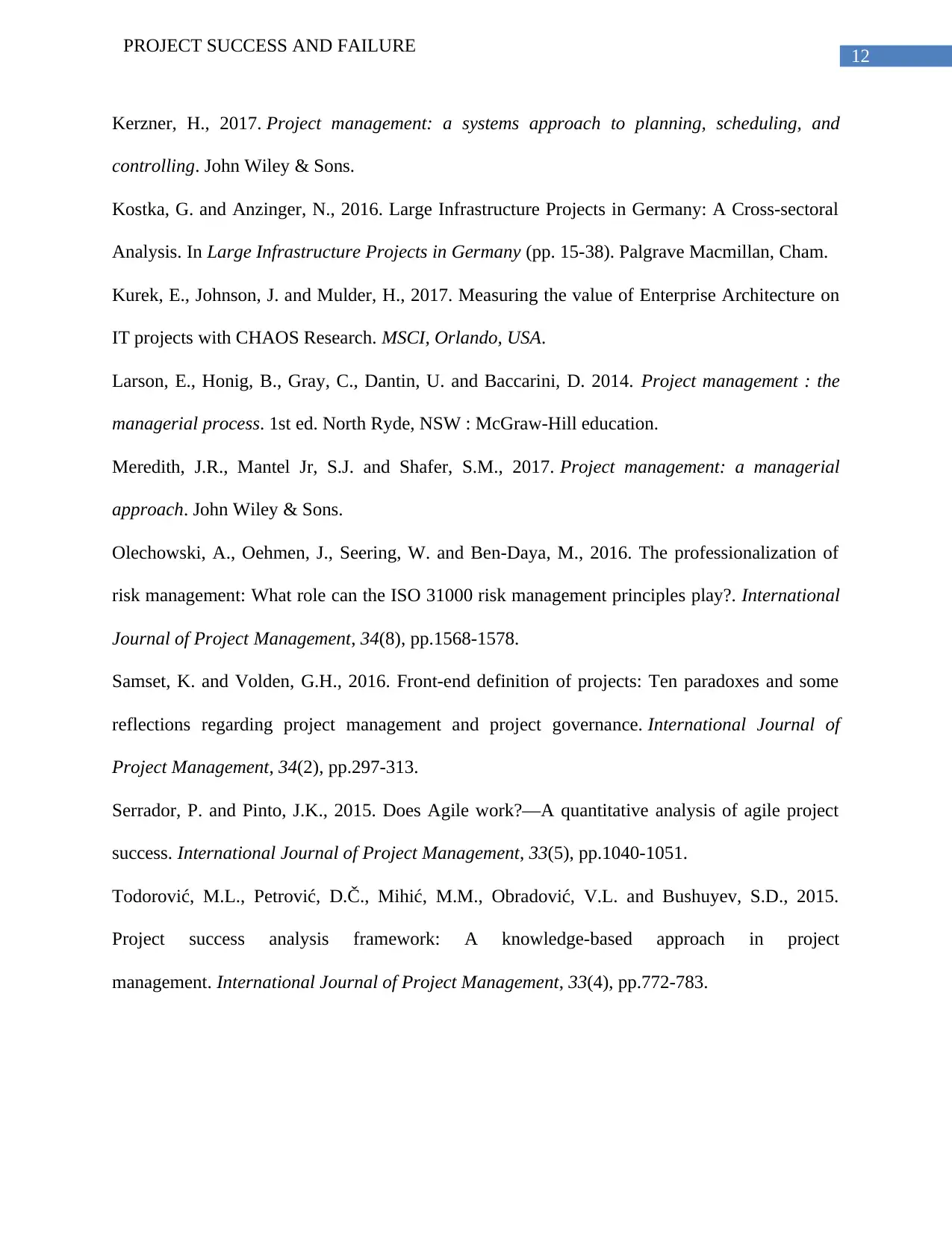
12
PROJECT SUCCESS AND FAILURE
Kerzner, H., 2017. Project management: a systems approach to planning, scheduling, and
controlling. John Wiley & Sons.
Kostka, G. and Anzinger, N., 2016. Large Infrastructure Projects in Germany: A Cross-sectoral
Analysis. In Large Infrastructure Projects in Germany (pp. 15-38). Palgrave Macmillan, Cham.
Kurek, E., Johnson, J. and Mulder, H., 2017. Measuring the value of Enterprise Architecture on
IT projects with CHAOS Research. MSCI, Orlando, USA.
Larson, E., Honig, B., Gray, C., Dantin, U. and Baccarini, D. 2014. Project management : the
managerial process. 1st ed. North Ryde, NSW : McGraw-Hill education.
Meredith, J.R., Mantel Jr, S.J. and Shafer, S.M., 2017. Project management: a managerial
approach. John Wiley & Sons.
Olechowski, A., Oehmen, J., Seering, W. and Ben-Daya, M., 2016. The professionalization of
risk management: What role can the ISO 31000 risk management principles play?. International
Journal of Project Management, 34(8), pp.1568-1578.
Samset, K. and Volden, G.H., 2016. Front-end definition of projects: Ten paradoxes and some
reflections regarding project management and project governance. International Journal of
Project Management, 34(2), pp.297-313.
Serrador, P. and Pinto, J.K., 2015. Does Agile work?—A quantitative analysis of agile project
success. International Journal of Project Management, 33(5), pp.1040-1051.
Todorović, M.L., Petrović, D.Č., Mihić, M.M., Obradović, V.L. and Bushuyev, S.D., 2015.
Project success analysis framework: A knowledge-based approach in project
management. International Journal of Project Management, 33(4), pp.772-783.
PROJECT SUCCESS AND FAILURE
Kerzner, H., 2017. Project management: a systems approach to planning, scheduling, and
controlling. John Wiley & Sons.
Kostka, G. and Anzinger, N., 2016. Large Infrastructure Projects in Germany: A Cross-sectoral
Analysis. In Large Infrastructure Projects in Germany (pp. 15-38). Palgrave Macmillan, Cham.
Kurek, E., Johnson, J. and Mulder, H., 2017. Measuring the value of Enterprise Architecture on
IT projects with CHAOS Research. MSCI, Orlando, USA.
Larson, E., Honig, B., Gray, C., Dantin, U. and Baccarini, D. 2014. Project management : the
managerial process. 1st ed. North Ryde, NSW : McGraw-Hill education.
Meredith, J.R., Mantel Jr, S.J. and Shafer, S.M., 2017. Project management: a managerial
approach. John Wiley & Sons.
Olechowski, A., Oehmen, J., Seering, W. and Ben-Daya, M., 2016. The professionalization of
risk management: What role can the ISO 31000 risk management principles play?. International
Journal of Project Management, 34(8), pp.1568-1578.
Samset, K. and Volden, G.H., 2016. Front-end definition of projects: Ten paradoxes and some
reflections regarding project management and project governance. International Journal of
Project Management, 34(2), pp.297-313.
Serrador, P. and Pinto, J.K., 2015. Does Agile work?—A quantitative analysis of agile project
success. International Journal of Project Management, 33(5), pp.1040-1051.
Todorović, M.L., Petrović, D.Č., Mihić, M.M., Obradović, V.L. and Bushuyev, S.D., 2015.
Project success analysis framework: A knowledge-based approach in project
management. International Journal of Project Management, 33(4), pp.772-783.
1 out of 13
Related Documents
Your All-in-One AI-Powered Toolkit for Academic Success.
+13062052269
info@desklib.com
Available 24*7 on WhatsApp / Email
![[object Object]](/_next/static/media/star-bottom.7253800d.svg)
Unlock your academic potential
© 2024 | Zucol Services PVT LTD | All rights reserved.



